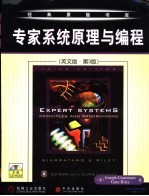图书介绍
专家系统原理与编程 英文版PDF|Epub|txt|kindle电子书版本网盘下载

- (美)JosephGiarratano,(美)GaryRiley著 著
- 出版社: 北京:机械工业出版社
- ISBN:7111108442
- 出版时间:2002
- 标注页数:597页
- 文件大小:22MB
- 文件页数:612页
- 主题词:
PDF下载
下载说明
专家系统原理与编程 英文版PDF格式电子书版下载
下载的文件为RAR压缩包。需要使用解压软件进行解压得到PDF格式图书。建议使用BT下载工具Free Download Manager进行下载,简称FDM(免费,没有广告,支持多平台)。本站资源全部打包为BT种子。所以需要使用专业的BT下载软件进行下载。如BitComet qBittorrent uTorrent等BT下载工具。迅雷目前由于本站不是热门资源。不推荐使用!后期资源热门了。安装了迅雷也可以迅雷进行下载!
(文件页数 要大于 标注页数,上中下等多册电子书除外)
注意:本站所有压缩包均有解压码: 点击下载压缩包解压工具
图书目录
CHAPTER 1:INTRODUCTION TO EXPERT SYSTEMS1
1.1 Introduction1
1.2 What Is an Expert System?1
1.3 Advantages of Expert Systems4
1.4 General Concepts of Expert Systems5
1.5 Characteristics of an Expert System8
1.6 The Development of Expert Systems Technology10
1.7 Expert Systems Applications and Domains15
1.8 Languages,Shells,and Tools21
1.9 Elements of an Expert System23
1.10 Production Systems28
1.11 Procedural Paradigms32
1.12 Nonprocedural Paradigms38
1.13 Artificial Neural Systems43
1.14 Connectionist Expert Systems and Inductive Learning49
1.15 Summary50
CHAPTER 2:THE REPRESENTATION OF KNOWLEDGE57
2.1 Introduction57
2.2 The Meaning of Knowledge57
2.3 Productions60
2.4 Semantic Nets63
2.5 Object-Attribute-Value Triples66
2.6 PROLOG and Semantic Nets67
2.7 Difficulties with Semantic Nets72
2.8 Schemata73
2.9 Frames74
2.10 Difficulties with Frames77
2.11 Logic and Sets78
2.12 Propositional Logic81
2.13 The First Order Predicate Logic86
2.14 The Universal Quantifier87
2.15 The Existential Quantifier88
2.16 Quantifiers and Sets90
2.17 Limitations of Predicate Logic91
2.18 Summary91
CHAPTER 3:METHODS OF INFERENCE97
3.1 Introduction97
3.2 Trees,Lattices,and Graphs97
3.3 State and Problem Spaces101
3.4 And-Or Trees and Goals106
3.5 Deductive Logic and Syllogisms109
3.6 Rules of Inference114
3.7 Limitations of Propositional Logic122
3.8 First Order Predicate Logic124
3.9 Logic Systems125
3.10 Resolution128
3.11 Resolution Systems and Deduction131
3.12 Shallow and Causal Reasoning133
3.13 Resolution and First Order Predicate Logic137
3.14 Forward and Backward Chaining143
3.16 Metaknowledge156
3.17 Summary157
4.1 Introduction165
4.2 Uncertainty165
CHAPTER 4:Reasoning Under Uncertainty165
4.3 Types of Error166
4.4 Errors and Induction168
4.5 Classical Probability169
4.6 Experimental and Subjective Probabilities173
4.7 Compound Probabilities175
4.8 Conditional Probabilities178
4.9 Hypothetical Reasoning and Backward Induction183
4.10 Temporal Reasoning and Markov Chains186
4.11 The Odds of Belief191
4.12 Sufficiency and Necessity193
4.13 Uncertainty in Inference Chains195
4.14 The Combination of Evidence200
4.15 Inference Nets207
4.16 The Propagation of Probabilities216
4.17 Summary220
CHAPTER 5:INEXACT REASONING227
5.1 Introduction227
5.2 Uncertainty and Rules227
5.3 Certainty Factors233
5.4 Dempster-Shafer Theory243
5.5 Approximate Reasoning256
5.6 The State of Uncertainty300
5.7 Summary301
CHAPTER 6:DESIGN OF EXPERT SYSTEMS309
6.1 Introduction309
6.2 Selecting the Appropriate Problem309
6.3 Stages in the Development of an Expert System311
6.4 Errors in Development Stages313
6.5 Software Engineering and Expert Systems315
6.6 The Expert System Life Cycle317
6.7 A Detailed Life Cycle Model320
6.8 Summary325
7.1 Introduction327
CHAPTER 7:INTRODUCTION TO CLIPS327
7.2 CLIPS328
7.3 Notation328
7.4 Fields330
7.5 Entering and Exiting CLIPS333
7.6 Facts334
7.7 Adding and Removing Facts337
7.8 Modifying and Duplicating Facts340
7.9 The Watch Command341
7.10 The Deffacts Construct342
7.11 The Components of a Rule344
7.12 The Agenda and Execution346
7.13 Commands for Manipulating Constructs350
7.14 The Printout Command353
7.15 Using Multiple Rules353
7.16 The Set-Break Command355
7.17 Loading and Saving Constructs357
7.18 Commenting Constructs358
7.19 Summary359
8.1 Introduction365
8.2 Variables365
CHAPTER 8:PATTERN MATCHING365
8.3 Multiple Use of Variables366
8.4 Fact Addresses367
8.5 Single-Field Wildcards370
8.6 Blocks World371
8.7 Multifield Wildcards and Variables376
8.8 Field Constraints382
8.9 Functions and Expressions385
8.10 Summing Values Using Rules389
8.11 The Bind Function391
8.12 I/O Functions392
8.13 Summary398
CHAPTER 9:ADVANCED PATTERN MATCHING405
9.1 Introduction405
9.2 The Game of Sticks405
9.3 Input Techniques405
9.4 Predicate Functions407
9.5 The Test Conditional Element407
9.6 The Predicate Field Constraint410
9.7 The Return Value Field Constraint411
9.8 The Sticks Program412
9.9 The OR Conditional Element413
9.10 The AND Conditional Element415
9.11 The NOT Conditional Element417
9.12 The EXISTS Conditional Element419
9.13 The FORALL Conditional Element422
9.14 The LOGICAL Conditional Element424
9.15 Utility Commands428
9.16 Summary430
CHAPTER 10:MODULAR DESIGN AND EXECUTION CONTROL437
10.1 Introduction437
10.2 Deftemplate Attributes437
10.3 Salience445
10.4 Phases and Control Facts448
10.5 Misuse of Salience453
10.6 The Defmodule Construct456
10.7 Importing and Exporting Facts459
10.8 Modules and Execution Control463
10.9 Summary471
CHAPTER 11:EFFICIENCY IN RULE-BASED LANGUAGES477
11.1 Introduction477
11.2 The Rete Pattern-Matching Algorithm477
11.3 The Pattern Network480
11.4 The Join Network483
11.5 The Importance of Pattern Order486
11.6 Ordering Patterns for Efficiency492
11.8 The Test CE and Efficiency493
11.7 Multifield Variables and Efficiency493
11.9 Built-In Pattern-Matching Constraints495
11.10 General Rules versus Specific Rules496
11.11 Procedural Functions498
11.12 Simple Rules versus Complex Rules500
11.13 Loading and Saving Facts503
11.14 Summary504
12.1 Introduction509
12.2 Certainty Factors509
CHAPTER 12:EXPERT SYSTEM DESIGN EXAMPLES509
12.3 Decision Trees513
12.4 Backward Chaining526
12.5 A Monitoring Problem538
12.6 Summary554
APPENDIX A:SOME USEFUL EQUIVALENCES557
APPENDIX B:SOME ELEMENTARY QUANTIERS AND THEIR MEANINGS559
APPENDIX C:SOME SET PROPERTIES561
APPENDIX D:CLIPS SUPPORT INFORMATION563
APPENDIX E:CLIPS COMMAND AND FUNCTION SUMMARY565
APPENDIX F:CLIPS BNF579
INDEX585